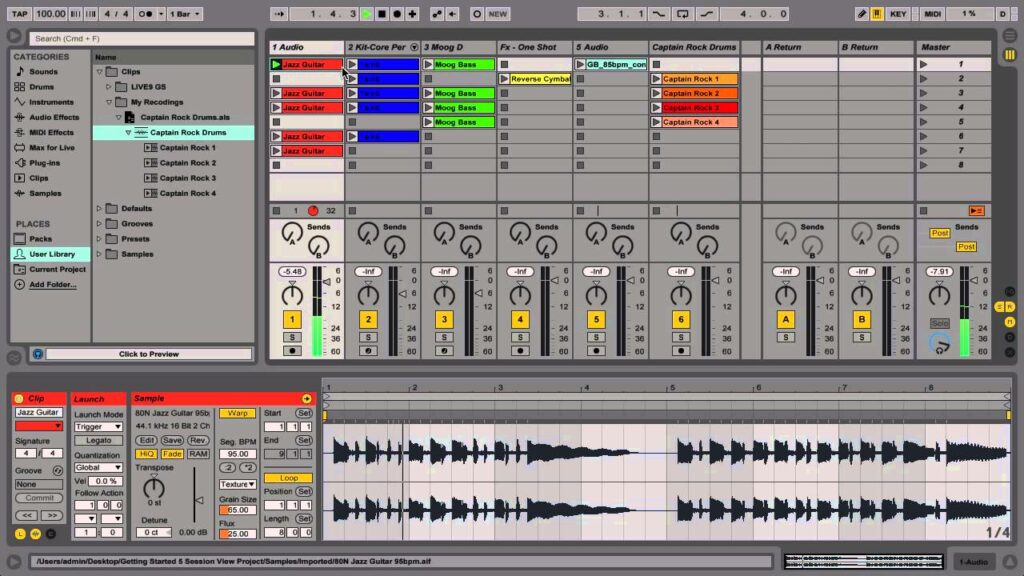Mastering Creativity and Performance: A Comprehensive Guide to Using Session View in Ableton Live

Ableton Live’s Session View stands as a cornerstone of creativity and flexibility in music production, offering a dynamic workspace where ideas can be captured, arranged, and performed in real-time. Whether you’re a seasoned producer, a live performer, or a curious beginner, mastering the intricacies of Session View opens up a world of possibilities for musical exploration and expression. In this extensive guide, we’ll delve deep into the functionality and workflow of Session View in Ableton Live, empowering you to harness its full potential and take your music to new heights.
Understanding Session View:
Before we dive into the specifics of using Session View, let’s establish a foundational understanding of its key features and functionality:
- Grid-Based Layout: Session View adopts a grid-based layout, with tracks arranged vertically and scenes arranged horizontally. Each cell in the grid, known as a clip slot, represents a musical idea or performance element.
- Clip-Based Workflow: Session View is centered around the concept of clips, which can contain MIDI sequences, audio loops, one-shot samples, or even entire arrangements. Clips can be triggered individually or grouped together within scenes for seamless playback.
- Non-Linear Composition: Unlike the linear timeline of Arrangement View, Session View allows for non-linear composition and improvisation. Clips can be launched, stopped, and rearranged on the fly, making it ideal for live performance and spontaneous creativity.
- Flexible Performance Environment: Session View serves as a versatile performance environment, where musicians can experiment with different combinations of sounds, textures, and arrangements in real-time. This makes it a favorite among DJs, electronic musicians, and performers seeking to push the boundaries of live music.
Getting Started with Session View:
Now that we have a solid understanding of Session View’s core concepts, let’s explore how to get started using it in Ableton Live:
- Launching Ableton Live and Accessing Session View:
- Upon launching Ableton Live, you’ll be presented with a choice between Session View and Arrangement View. Select Session View to enter the Session View workspace.
- Navigating the Session View Interface:
- Familiarize yourself with the layout of Session View, which consists of vertical tracks and horizontal scenes. Use the scroll bars to navigate vertically and horizontally through the grid.
- Understanding Tracks and Scenes:
- Tracks in Session View represent different instruments, audio channels, or MIDI sequences. Each track contains multiple clip slots where clips can be triggered and arranged.
- Scenes are horizontal rows of clip slots that allow you to group and trigger multiple clips simultaneously. Think of scenes as arrangements or sections within your performance.
- Creating and Launching Clips:
- To create a new clip, simply drag an instrument, audio file, or MIDI sequence from the Browser onto an empty clip slot in Session View.
- To launch a clip, simply click on the clip slot or press the corresponding MIDI or keyboard shortcut. Clips will play back in sync with Ableton Live’s global tempo.
Advanced Techniques and Workflow Tips:
Now that we’ve covered the basics of Session View, let’s explore some advanced techniques and workflow tips to enhance your productivity and creativity:
- Grouping and Routing:
- Use track grouping to organize related tracks, such as drums or synths, into nested groups for easier management and control.
- Take advantage of track routing to send audio from one track to another, allowing for parallel processing, layering, and creative sound design.
- Clip Automation and Modulation:
- Explore clip automation to add movement and variation to your clips over time. Use automation envelopes to control parameters such as volume, panning, and effect parameters within individual clips.
- Experiment with clip modulation to introduce randomness and unpredictability to your performances. Use tools such as the Random and Velocity MIDI effects to generate dynamic variations in your MIDI sequences.
- Follow Actions and Scene Launching:
- Utilize Follow Actions to create automatic clip triggering and looping behaviors within Session View. Define follow action parameters such as probability, time, and direction to create evolving and interactive performances.
- Experiment with scene launching to trigger entire arrangements or sections of your performance with a single click or MIDI command. Arrange your scenes to create dynamic builds, breakdowns, and transitions in your live sets.
Integrating Session View into Your Workflow:
As you become more comfortable with Session View, consider integrating it into your overall music production workflow in the following ways:
- Sketching Ideas and Arrangements:
- Use Session View as a sketchpad for capturing musical ideas, experimenting with arrangements, and brainstorming new compositions. Quickly record, loop, and layer clips to flesh out your ideas before transitioning to Arrangement View for detailed refinement.
- Live Performance and Jamming:
- Take advantage of Session View’s real-time performance capabilities to perform live sets, improvisational jams, and DJ mixes. Experiment with clip launching, scene triggering, and live looping to create dynamic and engaging performances on stage or in the studio.
- Collaboration and Remixing:
- Share Ableton Live projects with collaborators or remixers, allowing them to explore and manipulate your tracks within Session View. Collaboratively arrange, rearrange, and remix clips to create unique and collaborative musical experiences.
Conclusion:
Session View in Ableton Live represents a playground of creativity and innovation, where musical ideas can be captured, arranged, and performed in real-time. By mastering its features, techniques, and workflow, you’ll unlock a world of possibilities for musical exploration and expression.
Whether you’re sketching out ideas, performing live sets, or collaborating with other musicians, Session View serves as a versatile and dynamic environment for bringing your musical visions to life. So, dive in, experiment, and let the boundless creativity of Session View inspire your musical journey in Ableton Live!





